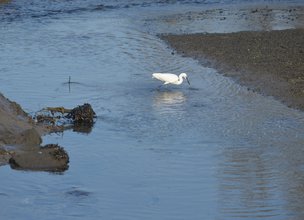Important places of refuge, feeding and reproduction of various species.
Resulting from the accumulation of river sand after contact with the estuarine saline wedge, can find in middle of the river, in the area of the average estuary of Lima, sandy formations called Ínsuas. Here, the vegetation is dominated by halophytes or salty reeds, often occurring mudflats on the banks.
These structures are well preserved in the Lima estuary, although there are stands of exotic plant species in some places, which should be monitored in order to control or eradicate these weeds.
In this place, inserted in the Lima Rive SCZ, the habitats contained in the Habitats Directive occur:
- 1130 - Estuaries
- 1140 - Mudflats and sands uncovered at low tide
- 1330 - Atlantic salty meadows (Galuco-Puccianellietalia maritimae)
- 1310 - Pioneer vegetation of Salicornia and other annual species in muddy and sandy areas
- 1320 - Meadows of Spartina (Spartinion maritimae).
Resulting from the accumulation of river sand after contact with the estuarine saline wedge, can find in middle of the river, in the area of the average estuary of Lima, sandy formations called Ínsuas. Here, the vegetation is dominated by halophytes or salty reeds, often occurring mudflats on the banks.
These structures are well preserved in the Lima estuary, although there are stands of exotic plant species in some places, which should be monitored in order to control or eradicate these weeds.
In this place, inserted in the Lima Rive SCZ, the habitats contained in the Habitats Directive occur:
- 1130 - Estuaries
- 1140 - Mudflats and sands uncovered at low tide
- 1330 - Atlantic salty meadows (Galuco-Puccianellietalia maritimae)
- 1310 - Pioneer vegetation of Salicornia and other annual species in muddy and sandy areas
- 1320 - Meadows of Spartina (Spartinion maritimae).
Location
These sandy formations occur on the bed in the middle estuary of the Lima River.
Coordinates
Lat: 41.69525
Long: -8.794917
Hello little one!
I'm Piquinhos and I can help you learn more about the Geopark!
Biodiversity
Biodiversity
The junco-das-esteiras (Juncus maritimus) is the dominant plant in the river island, also occurring communities of Puccianellia maritima, Festuca rubra subsp. littoralis, Armeria maritima and, in some places, the junco-agudo (Juncus acutus).
Among other exotic invaders, the acácia-de-espigas (Acacia longifolia) and the erva-das-pampas (Cortaderia selloana) have spread to the insides of the Lima River, threatening the indigenous biodiversity and the entire ecosystem. Due to its location in the middle estuary, an area where the greatest daily variations in salinity and temperature occur, the organisms that inhabit this area have adaptations that allow them to tolerate these variations, namely salinity, and survive in this environment - Eurihaline organisms.
Various species of birds, fish and other aquatic organisms are found in these local areas of refuge, food and reproduction, both in the middle of the vegetation and in the flooded channels that cross the islands. Thus, they can be found in the intrinsic water birds, such as gaivotas (Larus spp.), the guincho-comum (Chroicocephalus ridibundus), the corvo-marinho-de-faces-brancas (Phalacrocorax carbo), the garça-branca-pequena (Egretta garzetta), garça-branca-grande (Egretta alba) and garça-real (Ardea cinerea).You can also see patos-reais (Anas platyrhynchos) and the águia-pesqueira (Pandion haliaetus), which mainly uses this place to hunt and feed.
Several species of fish, crustaceans, molluscs, among others, can be found, either in larval or juvenile states, such as robalo (Dicentrarchus labrax), solha-das-pedras (Platichthys flesus), caranguejo-verde (Carcinus maenas) , the enguia-europeia (Anguilla anguilla) and the lampreia-do-mar (Petromyzon marinus).
Discover some of the species that can be found in this location, under the "Multimedia" tab.
Child Mode
Discover the geopark in a simpler format, aimed at the little ones.
Clique ENTER para pesquisar ou ESC para sair
